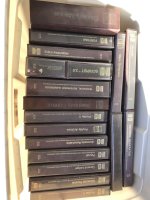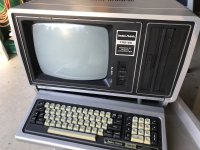Qbus
Veteran Member
Picked up a TRS-80 II system with eight-inch drive, printer and lots of documentation and software. Going to assume that this was a larger version of the TRS-80 system that was maybe intended for business? Or something back in the days before DOS ruled the world?
Going to list it for sale down in the sale section but if no one is interested may end up cleaning it up and playing around with it. A couple questions first, One- Going to assume that just like the TRS-80 they had some form of Basic in ROM and that is the operating system? Load and Save commands will allow reading and writing to the local drive? Second- what type of power supply did they use? Was it a linear or switching supply? Don’t want to do it yet because I just listed it for sale but if no one is interested will take everything apart and clean it all up including looking at the power supplies but the system still has its stickers from the last time Radio Shack serviced the system back forty or so years ago and before I tear them want to give who ever buys it that option.
Back in 77/78 in High School remember the TRS-80 and seeing them at that time, never owned one but have some experience running PC/DOS Basic and lots of time spent playing around with DEC systems and working in Basic in that environment so going to assume that Radio Shack Basic cannot be that different from MS or GW Basic.
Going to list it for sale down in the sale section but if no one is interested may end up cleaning it up and playing around with it. A couple questions first, One- Going to assume that just like the TRS-80 they had some form of Basic in ROM and that is the operating system? Load and Save commands will allow reading and writing to the local drive? Second- what type of power supply did they use? Was it a linear or switching supply? Don’t want to do it yet because I just listed it for sale but if no one is interested will take everything apart and clean it all up including looking at the power supplies but the system still has its stickers from the last time Radio Shack serviced the system back forty or so years ago and before I tear them want to give who ever buys it that option.
Back in 77/78 in High School remember the TRS-80 and seeing them at that time, never owned one but have some experience running PC/DOS Basic and lots of time spent playing around with DEC systems and working in Basic in that environment so going to assume that Radio Shack Basic cannot be that different from MS or GW Basic.


